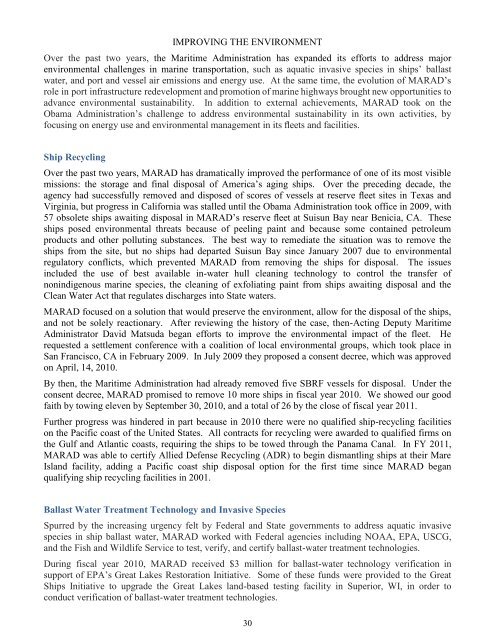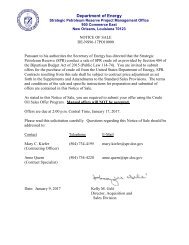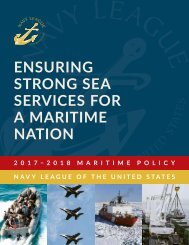2010-11_ANNUAL_REPORTS_-_FINAL_VERSION_(3)
2010-11_ANNUAL_REPORTS_-_FINAL_VERSION_(3)
2010-11_ANNUAL_REPORTS_-_FINAL_VERSION_(3)
Create successful ePaper yourself
Turn your PDF publications into a flip-book with our unique Google optimized e-Paper software.
IMPROVING THE ENVIRONMENT<br />
Over the past two years, the Maritime Administration has expanded its efforts to address major<br />
environmental challenges in marine transportation, such as aquatic invasive species in ships’ ballast<br />
water, and port and vessel air emissions and energy use. At the same time, the evolution of MARAD’s<br />
role in port infrastructure redevelopment and promotion of marine highways brought new opportunities to<br />
advance environmental sustainability. In addition to external achievements, MARAD took on the<br />
Obama Administration’s challenge to address environmental sustainability in its own activities, by<br />
focusing on energy use and environmental management in its fleets and facilities.<br />
Ship Recycling<br />
Over the past two years, MARAD has dramatically improved the performance of one of its most visible<br />
missions: the storage and final disposal of America’s aging ships. Over the preceding decade, the<br />
agency had successfully removed and disposed of scores of vessels at reserve fleet sites in Texas and<br />
Virginia, but progress in California was stalled until the Obama Administration took office in 2009, with<br />
57 obsolete ships awaiting disposal in MARAD’s reserve fleet at Suisun Bay near Benicia, CA. These<br />
ships posed environmental threats because of peeling paint and because some contained petroleum<br />
products and other polluting substances. The best way to remediate the situation was to remove the<br />
ships from the site, but no ships had departed Suisun Bay since January 2007 due to environmental<br />
regulatory conflicts, which prevented MARAD from removing the ships for disposal. The issues<br />
included the use of best available in-water hull cleaning technology to control the transfer of<br />
nonindigenous marine species, the cleaning of exfoliating paint from ships awaiting disposal and the<br />
Clean Water Act that regulates discharges into State waters.<br />
MARAD focused on a solution that would preserve the environment, allow for the disposal of the ships,<br />
and not be solely reactionary. After reviewing the history of the case, then-Acting Deputy Maritime<br />
Administrator David Matsuda began efforts to improve the environmental impact of the fleet. He<br />
requested a settlement conference with a coalition of local environmental groups, which took place in<br />
San Francisco, CA in February 2009. In July 2009 they proposed a consent decree, which was approved<br />
on April, 14, <strong>2010</strong>.<br />
By then, the Maritime Administration had already removed five SBRF vessels for disposal. Under the<br />
consent decree, MARAD promised to remove 10 more ships in fiscal year <strong>2010</strong>. We showed our good<br />
faith by towing eleven by September 30, <strong>2010</strong>, and a total of 26 by the close of fiscal year 20<strong>11</strong>.<br />
Further progress was hindered in part because in <strong>2010</strong> there were no qualified ship-recycling facilities<br />
on the Pacific coast of the United States. All contracts for recycling were awarded to qualified firms on<br />
the Gulf and Atlantic coasts, requiring the ships to be towed through the Panama Canal. In FY 20<strong>11</strong>,<br />
MARAD was able to certify Allied Defense Recycling (ADR) to begin dismantling ships at their Mare<br />
Island facility, adding a Pacific coast ship disposal option for the first time since MARAD began<br />
qualifying ship recycling facilities in 2001.<br />
Ballast Water Treatment Technology and Invasive Species<br />
Spurred by the increasing urgency felt by Federal and State governments to address aquatic invasive<br />
species in ship ballast water, MARAD worked with Federal agencies including NOAA, EPA, USCG,<br />
and the Fish and Wildlife Service to test, verify, and certify ballast-water treatment technologies.<br />
During fiscal year <strong>2010</strong>, MARAD received $3 million for ballast-water technology verification in<br />
support of EPA’s Great Lakes Restoration Initiative. Some of these funds were provided to the Great<br />
Ships Initiative to upgrade the Great Lakes land-based testing facility in Superior, WI, in order to<br />
conduct verification of ballast-water treatment technologies.<br />
30




